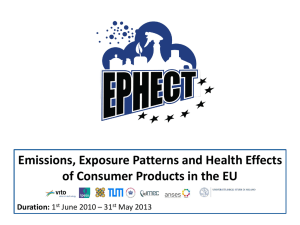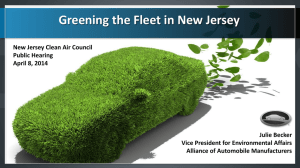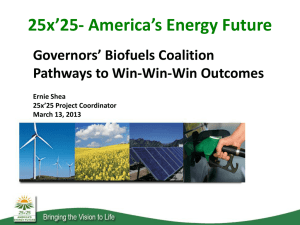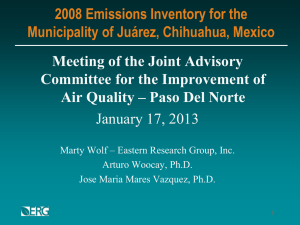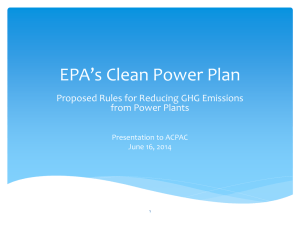PowerPoint - Global Carbon Project
advertisement
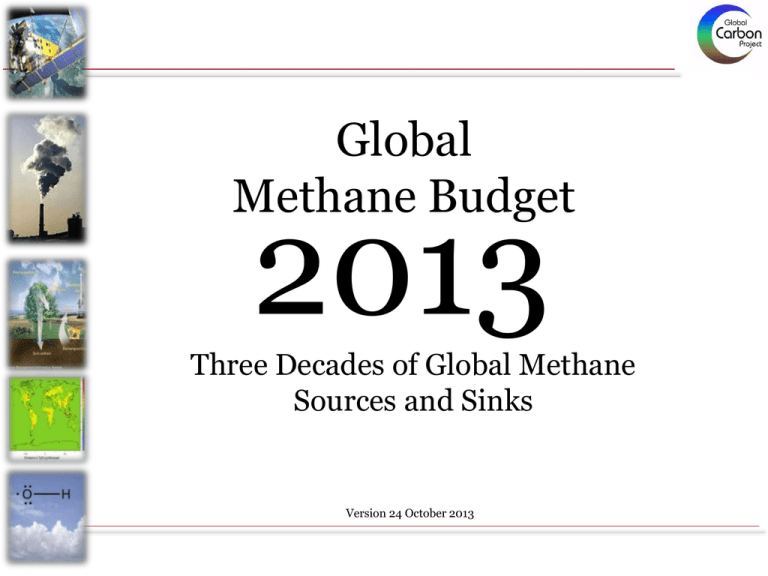
Global Methane Budget 2013 Three Decades of Global Methane Sources and Sinks Version 24 October 2013 Acknowledgements The work presented here has been possible thanks to the enormous observational and modeling efforts of the institutions and networks below: Atmospheric CH4 datasets •NOAA/ESRL (Dlugokencky et al., 2011) •AGAGE (Rigby et al., 2008) •CSIRO (Francey et al., 1999) •UCI (Simpson et al., 2012) Top-down atmospheric inversions •TM5-4DVAR (Bergamaschi et al., 2009) •LMDZ-MIOP (Bousquet et al., 2011) •CarbonTracker-CH4 (Bruhwiler et al., 2012) •GEOS-Chem (Fraser et al., 2013) •TM5-4DVAR (Beck et al., 2012) •LMDZt-SACS (Pison et al., 2009; Bousquet et al., 2011) •MATCH model (Chen & Prinn, 2006) •TM2 model (Hein et al., 1997) •GISS model (Fung et al. 1991) Bottom-up studies data and modeling • LPJ-wsl (Hodson et al, 2011) • ORCHIDEE (Ringeval et al., 2011) • LPJ-WhyMe (Spahni et al., 2011) • GICC (Mieville et al., 2010) • RETRO (Schultz et al., 2007) • GFEDv2 (Van der Werf et al., 2004) • GFEDv3 (Van der Werf et al., 2010) • FINNv1 (Wiedinmyer et al., 2011) • IIASA (Dentener et al., 2005) • EPA, 2011 • EDGARv4.1 (EDGAR4.1, 2009) • EDGARv4.2 (EDGAR4.2, 2011) • Description of models contributing to the Atmospheric Chemistry and Climate Model • Intercomparison Project (ACCMIP, Lamarque et al., 2013; Voulgarakis et al., 2013; Naik et al., 80 2013) • TM5 full chemistry model (Williams et al., 2012; Huijnen et al., 2010) Full references provided in Kirschke et al. 2013, Nature Geoscience The Contributors Stefanie Kirschke Laboratoire des Sciences du Climat et de l’Environnement, CEA-UVSQ-CNRS, France Philippe Bousquet Laboratoire des Sciences du Climat et de l’Environnement, CEA-UVSQ-CNRS, France Philippe Ciais Laboratoire des Sciences du Climat et de l’Environnement, CEA-UVSQ-CNRS, France Marielle Saunois Laboratoire des Sciences du Climat et de l’Environnement, CEA-UVSQ-CNRS, France Josep G. Canadell Global Carbon Project, CSIRO Marine and Atmospheric Research, Australia Edward J. Dlugokencky NOAA Earth System Research Laboratory, USA Peter Bergamaschi Joint Research Centre, Italy Daniel Bergmann Lawrence Livermore National Laboratory, USA Donald R. Blake University of California, USA Lori Bruhwiler Institute for Environment and Sustainability Philip Cameron-Smith Lawrence Livermore National Laboratory, USA Simona Castaldi Department of Environmental Sciences, Second University of Naples, Italy CMCC, Italy Frédéric Chevallier Laboratoire des Sciences du Climat et de l’Environnement, CEA-UVSQ-CNRS, France Liang Feng School of GeoSciences, University of Edinburgh, UK Annemarie Fraser School of GeoSciences, University of Edinburgh, UK Paul J. Fraser Centre for Australian Weather and Climate Research/CSIRO Marine and Atmospheric Research, Australia Martin Heimann MPI Biogeochemistry, Germany Elke L. Hodson Swiss Federal Research Institute WSL, Switzerland Sander Houweling SRON, The Netherlands Institue for Marine and Atmospheric research, The Netherlands Béatrice Josse Météo France, France Paul B. Krummel Centre for Australian Weather and Climate Research/CSIRO Marine and Atmospheric Research, Australia Jean-François Lamarque NCAR, USA Ray L. Langenfelds Centre for Australian Weather and Climate Research/CSIRO Marine and Atmospheric Research, Australia Corinne Le Quéré Tyndall Centre for Climate Change Research, UK Vaishali Naik UCAR/GFDL, USA Simon O'Doherty University of Bristol, UK Paul I. Palmer School of GeoSciences, University of Edinburgh, UK Isabelle Pison Laboratoire des Sciences du Climat et de l’Environnement, UMR CEA-CNRS-UVSQ, France David Plummer CCCma, Environment Canada, Canada Benjamin Poulter Laboratoire des Sciences du Climat et de l’Environnement, CEA-UVSQ-CNRS, Fran Ronald G. Prinn Massachusetts Institute of Technology, USA Matt Rigby School of Chemistry, University of Bristol, UK Bruno Ringeval Institue for Marine and Atmospheric research, The Netherlands IMAU, Utrecht University, The Netherlands Department of Systems Ecology, VU University, The Netherlands Monia Santini Centro euro-Mediterraneo per i Cambiamenti Climatici (CMCC), Italy Martina Schmidt Laboratoire des Sciences du Climat et de l’Environnement, CEA-UVSQ-CNRS, Franc Drew T. Shindell NASA GISS, USA Renato Spahni University of Bern, Switzerland L. Paul Steele Centre for Australian Weather and Climate Research/CSIRO Marine and Atmospheric Research, Australia Sarah A. Strode NASA GSFC, USA Universities Space Research Association, USA Kengo Sudo Graduate School of Environmental Studies, Nagoya University Furo-cho, Japan Sophie Szopa Laboratoire des Sciences du Climat et de l’Environnement, CEA-UVSQ-CNRS, France Guido R. van der Werf VU University, The Netherlands Apostolos Voulgarakis NASA GISS, USA Department of Physics, Imperial College, UK Michiel van Weele Royal Netherlands Meteorological Institute (KNMI), The Netherlands Ray F. Weiss Scripps Institution of Oceanography, USA Jason E. Williams Royal Netherlands Meteorological Institute (KNMI), The Netherlands Guang Zeng National Institute of Water and Atmospheric Research, New Zealand The Activity • The Global Methane Budget is the new companion activity of the Global Carbon Budget activity http://www.globalcarbonproject.org/carbonbudget of the Global Carbon Project, a project of the IGBP, WCRP, IHDP, and Diversitas. • The activity aims to update the budget on a regular basis (annually or bi-annually) and extend its analysis. • It focuses on analyses and syntheses of existing data, models, and estimates from bottom-up approaches (inventories, models) and top-down approaches (atmospheric inversions). • It relies on contributions from a number of networks and institutions (see Acknowledgements) – – – – – Observational networks (NOAA, CSIRO, UCI, AGAGE) Inventories (EDGAR, EPA, IIASA) Wetland models, biomass burning data sets Inverse modeling systems for atmospheric transport Chemical transport models for OH sink • Global Methane Budget Website http://www.globalcarbonproject.org/methanebudget • This effort has contributed to the IPCC 5th Assessment Report, Working Group I, Chapter 6 The First Effort Stefanie Kirschke, Philippe Bousquet, Philippe Ciais, Marielle Saunois, Josep G. Canadell, Edward J. Dlugokencky, Peter Bergamaschi, Daniel Bergmann, Donald R. Blake, Lori Bruhwiler, Philip Cameron-Smith, Simona Castaldi, Frédéric Chevallier, Liang Feng, Annemarie Fraser, Martin Heimann, Elke L. Hodson, Sander Houweling, Béatrice Josse, Paul J. Fraser, Paul B. Krummel, Jean-François Lamarque, Ray L. Langenfelds, Corinne Le Quéré, Vaishali Naik, Simon O'Doherty, Paul I. Palmer, Isabelle Pison, David Plummer, Benjamin Poulter, Ronald G. Prinn, Matt Rigby, Bruno Ringeval, Monia Santini, Martina Schmidt, Drew T. Shindell, Isobel J. Simpson, Renato Spahni, L. Paul Steele, Sarah A. Strode, Kengo Sudo, Sophie Szopa, Guido R. van der Werf, Apostolos Voulgarakis, Michiel van Weele, Ray F. Weiss, Jason E. Williams & Guang Zeng (2013) Three decades of global methane sources and sinks. Nature Geoscience. doi:10.1038/ngeo1955. Published online 22 September 2013. http://www.nature.com/ngeo/journal/vaop/ncurrent/full/ngeo1955.html The Context • After carbon dioxide (CO2), methane (CH4) is the second most important well-mixed greenhouse gas contributing to humaninduced climate change. • In a time horizon of 100 years, CH4 has a Global Warming Potential 28 times larger than CO2. • CH4 is responsible for 20% of the global warming produced by all well-mixed greenhouse gases, and constitutes 60% of the climate forcing by CO2 (0.97 Wm-2 vs 1.68 Wm-2) since pre-Industrial time. • Annual globally averaged CH4 concentration was 1803±4 parts per billion in 2011 and 722 ppb in 1750. 150% increase since pre-Industrial time. Updated to 2012 • CH4 contributes to water vapor in the stratosphere, and to ozone production in the troposphere, the latter a pollutant with negative impacts on human health and ecosystems. • The atmospheric life time of CH4 is approximately 10±2 years. IPCC WGI 2013; Voulgarakis et al. 2013, Atmos. Chem. Phys. Atmospheric Observations Emission Inventories Biogeochemistry Models Inverse Models OH Sink The Tools and Data Ground-based data from observation networks (AGAGE, CSIRO, NOAA, UCI). Agriculture and waste related emissions, fossil fuel emissions (EDGAR, EPA, IIASA). Airborne observations. Fire emissions (GFED, GICC, FINN, RETRO). Satellite data. Ensemble of different wetland models, (LPJWHyMe, LPJ-wsl, ORCHIDEE). Data and models to calculate annual flooded area. Suite of different atmospheric inversion models (TM5-4DVAR, LMDZ-MIOP, CarbonTrackerCH4, GEOS-Chem, LMDZt-SACS, MATCH, TM2, GISS). TransCom intercomparison. Long-term trends and decadal variability of the OH sink. ACCMIP CTMs intercomparison. Decadal Budgets CH4 Atmospheric Growth Rate, 1983-2009 1983-1989: 12 ± 6 ppb 1990-1999: 6 ± 8 ppb 2000-2009: 2 ± 2 ppb • Slowdown of atmospheric growth rate before 2005 • Resumed increase after 2006 Kirschke et al. 2013, Nature Geoscience; Data from NOAA, CSIRO, AGAGE, UCI atmospheric networks Global Carbon Project 2013; Figure based on Kirschke et al. 2013, Nature Geoscience Global Carbon Project 2013; Figure based on Kirschke et al. 2013, Nature Geoscience Global Carbon Project 2013; Figure based on Kirschke et al. 2013, Nature Geoscience Tg CH4 yr–1 1980–1989 Top-Down Sources Natural Sources Bottom-Up 1990–1999 Top-Down Bottom-Up 2000–2009 Top-Down Bottom-Up 203 [150–267] 355 [244–466] 182 [167–197] 336 [230–465] 218 [179–273] 347 [238–484] Natural Wetlands Other Sources Anthropogen. Sources Agriculture & Waste Rice Ruminants Landfills & Waste Biomass Burning Fossil Fuels Sinks Total Chemical Loss Global 167 [115–231] 36 [35-36] 225 [183–266] 130 [61-200] 150 [144–160] 32 [23-37] 206 [169–265] 130 [61-200] 175 [142–208] 43 [37-65] 217 [177–284] 130 [61-200] 348 [305–383] 308 [292-323] 372 [290–453] 313 [281–347] 335 [273–409] 331 [304–368] 208 [187-220] 46 [43-55] 94 [75-108] 185 [172-197] 43 [41-47] 85 [81-90] 55 [50-60] 34 [31-37] 89 [89-89] 239 [180-301] 38 [26-45] 95 [84-107] 187 [177-196] 35 [32-37] 86 [82-91] 65 [63-68] 42 [38-45] 84 [66-96] 209 [180-241] 30 [24-45] 96 [77-123] 200 [187-224] 36 [33-40] 89 [87-94] 75 [67-90] 35 [32-39] 96 [85-105] 490 [450–533] 539 [411–671] 525 [491–554] 571 [521–621] 518 [510–538] 604 [483–738] 551 [500–592] 663 [536-789] 554 [529–596] 649 [511-812] 548 [526–569] 678 [542-852] 511 [460–559] 539 [420-718] 542 [518–579] 596 [530–668] 540 [514–560] 632 [592–785] Sum of Sources Sum of Sinks Imbalance (Sources-Sinks) Atmospheric Growth Rate 30 [16–40] 12 [7–17] 8 [-4–19] 34 17 6 Larger global total emissions from Bottom-Up (inventories, models) than TopDown (atmospheric inversions) because of larger natural emissions Large uncertainties remain for wetland emissions (min-max range) ~50 Tg global imbalance in B-U approaches (T-D constrained by atmosphere) Increasing OH loss between decades in B-U (not clear in T-D) Evolution of Uncertainty: Decadal Budgets - No source or sink reaches the maximum level of confidence (large green circle) - Robustness is larger in the 2000s than in previous decades - Agreement can go down as more studies appear (e.g. fire, wetlands, OH, …) Kirschke et al. 2013, Nature Geoscience Regional Methane Budget • Dominance of wetland emissions in the tropics and boreal regions • Dominance of agriculture & waste in India and China • Balance between agriculture & waste and fossil fuels at midlatitudes • Uncertain magnitude of wetland emissions in tropical South America between T-D and B-U Kirschke et al. 2013, Nature Geoscience Emissions & Sinks Anthropogenic Methane Sources (2000s) Global Carbon Project 2013; Figure based on Kirschke et al. 2013 Natural Methane Sources (2000s) Global Carbon Project 2013; Figure based on Kirschke et al. 2013 Methane Sinks (2000s) Global Carbon Project 2013; Figure based on Kirschke et al. 2013 Agriculture/Waste CH4 Emissions (T-D) (T-D) (T-D) (T-D) (T-D) (B-U) (T-D) Top-Down estimates (B-U) Bottom-Up estimates Global Carbon Project 2013; Figure based on Kirschke et al. 2013. Data sources shown in figure. Biomass Burning CH4 Emissions (T-D) (T-D) (T-D) Top-Down estimates (B-U) Bottom-Up estimates (T-D) (T-D) (T-D) (B-U) (B-U) (B-U) (B-U) (B-U) Global Carbon Project 2013; Figure based on Kirschke et al. 2013. Data sources shown in figure. Wetland CH4 Emissions, 1980-2009 (T-D) (T-D) (T-D) Top-Down estimates (B-U) Bottom-Up estimates (T-D) (T-D) (T-D) (B-U) (T-D) (T-D) Increase 2005-2009 in B-U models due to precipitation forcing (increase in tropical land precipitation) Global Carbon Project 2013; Figure based on Kirschke et al. 2013. Data sources shown in figure. Fossil Fuel CH4 Emissions (T-D) (T-D) (T-D) Top-Down estimates (B-U) Bottom-Up estimates (T-D) (T-D) (T-D) (T-D) Global Carbon Project 2013; Figure based on Kirschke et al. 2013. Data sources shown in figure. Spatial Distribution of Fluxes Kirschke et al. 2013, Supplementary Information, Nature Geoscience Data sources: Wetland emissions (ORCHIDEE, LPJ-WHyMe, LPJ-wsl), Biomass burning emissions: GFED2, GFED3, RETRO, GICC). Interannual Variability of CH4 Emissions • Natural wetlands dominate IAV with contribution of BBG during large fires events • Trends in emissions are not fully consistent between models (cf fossil, wetlands) • Causes of the stabilisation period (1999-2006) and increasing period (>2006) still uncertain (fossil / wetlands?) Kirschke et al. 2013, Supplementary Information, Nature Geoscience Interannual Variability by Latitude Kirschke et al. 2013, Supplementary Information, Nature Geoscience Scenarios of Temporal Change Scenarios of Temporal Change S0 : EDGAR/EPA +wetlands Range of global emissions (from atm. Obs & inversions) Range of wetland emissions (B-U= light green, T-D = dark green) 5-year emission changes since 1985 for 3 categories Scenarios of Temporal Change S0 : EDGAR/EPA +wetlands Range of global emissions can be matched with decreasing fugitive emissions S1 : Decreasing fugitive emissions from 1985 to 2000 + EDGAR/EPA + wetlands (TD or BU) 5-year emission changes since 1985 for 3 categories Scenarios of Temporal Change S0 : EDGAR/EPA +wetlands Range of global emissions can be matched with stable fossil and microbial emissions S1 : Decreasing fugitive emissions from 1985 to 2000 + EDGAR/EPA + wetlands (TD or BU) S2 : Stable fossil and microbial between 1990 and 2005 + EDGAR/EPA +wetlands (TD or BU) 5-year emission changes since 1985 for 3 categories Scenarios of Temporal Change S0 : EDGAR/EPA +wetlands Range of global emissions is less matched by stable fossil and decreasing microbial emissions S1 : Decreasing fugitive emissions from 1985 to 2000 + EDGAR/EPA + wetlands (TD or BU) S2 : Stable fossil and microbial between 1990 and 2005 + EDGAR/EPA +wetlands (TD or BU) S3 : Decreasing microbial and stable fossil + EDGAR/EPA + wetlands (TD or BU) 5-year emission changes since 1985 for 3 categories Scenarios of Temporal Change S0 : EDGAR/EPA +wetlands After 2005 : Too fast increase for all scenarios ! S1 : Decreasing fugitive emissions from 1985 to 2000 + EDGAR/EPA + wetlands (TD or BU) S2 : Stable fossil and microbial between 1990 and 2005 + EDGAR/EPA +wetlands (TD or BU) S3 : Decreasing microbial and stable fossil + EDGAR/EPA + wetlands (TD or BU) 5-year emission changes since 1985 for 3 categories Results of the Scenario Analysis Stabilisation period (1999-2006): Decreasing to stable fossil fuel emissions and stable to increasing microbial emissions are more likely Resumed atmospheric increase (>2006) : Mix of fossil fuel and wetland emissions increase, but relative magnitude remains uncertain Final Key Points • • • • • • • • • Among datasets and models, consistency is higher on anthropogenic decadal emissions than natural ones. The large uncertainties in the mean emissions from natural wetlands limit our ability to fully close the CH4 budget. Global emissions as inferred from the sum of all individual emission sources are likely too high as they cannot use the overall atmospheric constraint. Little ability of the top-down atmospheric inversions to partition emissions among source types. Still large uncertainties on decadal means but reduced compared to the IPCC 4th Assessment Report. Interannual variability is dominated by natural wetlands, with short-term impacts of biomass burning. More robust than decadal means. 1999-2006 : fossil fuel emissions with microbial emissions more likely than other tested scenarios. Changes after 2005 still debated between wetlands and fossil fuels Improved agreement for a small OH interannual variability in the 2000s between top-down and bottom-up estimates. Global Methane Budget Website http://www.globalcarbonproject.org/methanebudget Activity Contacts E-mail Philippe Bousquet philippe.bousquet@lsce.ipsl.fr Anna Peregon anna.peregon@lsce.ipsl.fr Pep Canadell pep.canadell@csiro.au



